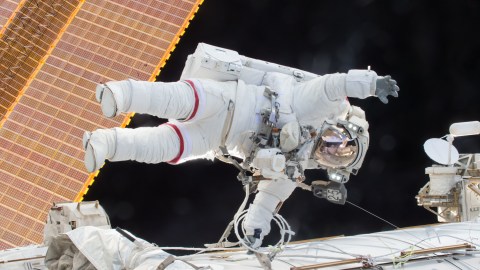Long spaceflights change astronauts’ brain structure, new study suggests

Photo by NASA via Getty Images
- A new study finds that long term weightlessness can cause changes in brain structure, with an increase in white matter lasting a year after returning to Earth.
- The researchers believe it to be caused by an increase in fluid pressure on the brain.
- Potential solutions include creating artificial gravity.
Humans have only been going to space since 1961. Long term stays are even more recent. The difficulties these stays can cause, such as reduced bone mass and vision problems, are increasingly well known. However, new issues are still being discovered. Just last week, a new study suggested that long term spaceflight has yet another side effect, structural changes to the brain itself.
I think my desire to go to space just declined a bit.
Eleven astronauts, ten men and one woman, were given MRI tests before they went for extended stays on the International Space Station. They were then given follow up scans the day after their return and at several points during the year after.
Not only did the researchers find that long-term exposure to zero-gravity increased the amount of cerebrospinal fluid in the brain, but that the amount of white matter in the brain increased as well. Several of the astronauts also had deformed pituitary glands, the gland that tells all the others what to do, as a result of the increased pressure on it.
These changes lasted for some time, just as other astronauts’ vision problems have continued for years after returning to Earth. This suggests that some of the effects, particularly the increased amount of fluid, might be permanent. The higher amount of fluid also flowed through the cerebral aqueduct at an increased velocity.
The researchers hypothesized that these changes, like the previously mentioned vision problems, were caused by increased pressure in the head itself caused by an increased amount of fluid present, including blood. While Earth’s gravity causes fluid to flow out of the head and pool towards the lower part of the body, weightlessness removes this tendency, and fluids begin to shift their locations. This effect has been known for a while and is also why many astronauts look like they skipped leg day or have puffy faces when they take pictures in space.
What does this mean? Are astronauts in danger?
It is too early to say what these changes to the brain mean. While some of the changes are associated with other symptoms, none of those have been seen in any of the astronauts yet.
However, ideas for how to reduce the build-up of fluids in the head are already being put forward. One suggestion is to create artificial gravity through the rotation of a centrifuge, like the spaceship in “2001: A Space Odyssey” has, or to create negative pressure around the lower parts of the body to draw fluid to them. Either of these mechanisms would cause less fluid to remain in the head.
The human body evolved to function decently in an environment where gravity is always a factor. As humanity ventures out towards the stars, the problem of how to keep that body working in such an alien environment will be a substantial obstacle. However, if we can solve the problem of getting into space in the first place, the issue of keeping fluid out of our heads seems comparatively simple.





